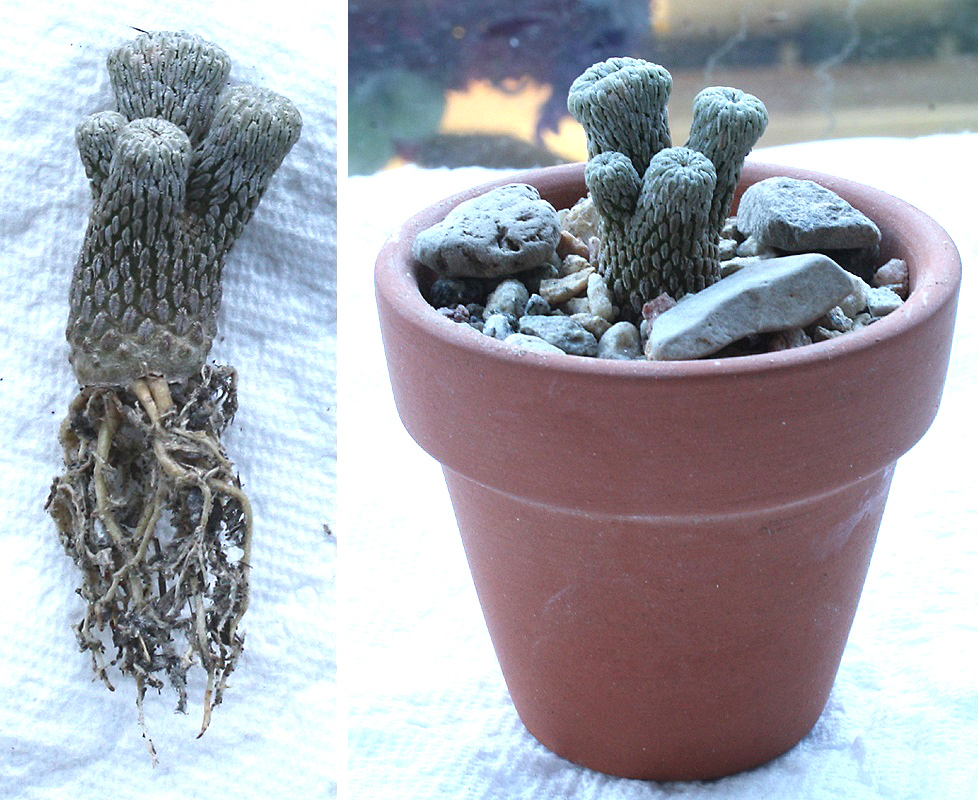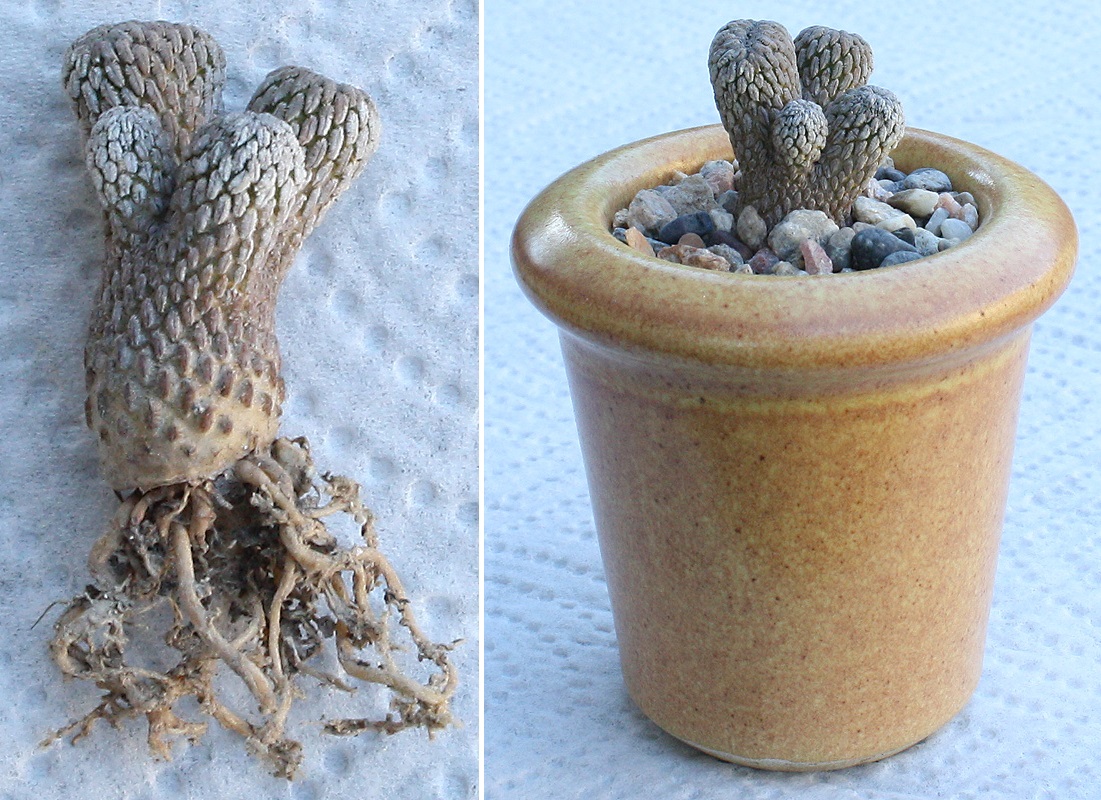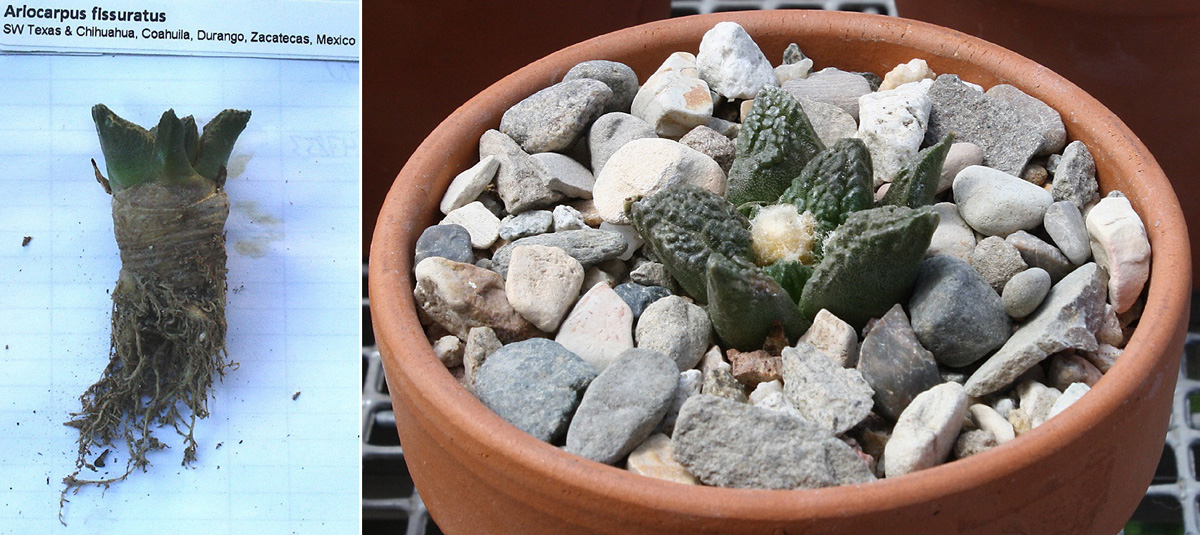In today's presentation, we'll review 2 cacti that are easy to grow, and 2 that are definitely not for beginners. (Don't worry -- if you
are a beginner, you won't be for long!)
Stenocactus
Formerly known as Echinofossulocactus (say that 5 times fast!

), the genus is remarkably tolerant of beginner mistakes. Good thing too, since this young beginner did well with Stenocactus when he killed cacti that were beyond his incredibly limited expertise. Back in the 1970s and '80s, crispatus and multicostatus were the only species I could find at my local nurseries. I counted both of them as old favorites on the list when I reacquainted myself with the California Cactus Center in June 2011, so multicostatus it was. And I managed to kill it with Neem oil spray -- that was the first and last time I would use it on anything. Truth be told, I wasn't exactly heartbroken about it, so thanks to Cactuspedia, I found a Steno that is a lot more interesting...
- S. zacatecasensis (CoronaCactus Nursery, July 2012)
(If you can say
that 5 times fast, you're scary good!


) First photos on 7/15 and 7/21/12:

Moving the zacatecasensis from "dirty" mineral mix to clean mix in February 2016, let's compare the roots from its time of arrival with what came out of its terracotta pot on 2/28:

The repot into glazed ceramic:

Growing progress on 9/21/13, 90/20/15, 9/17/16, and 10/20/18:


The view from above showing almost 6 years of growth on 3/16/13 and 10/20/18:

A slow, but strong little grower, and while the zacatecasensis isn't quite mature enough to bloom yet, next year could be the year to see its first flower. Steno flowers are quite pretty, so this is something to look forward to.
- S. lloydii (Miles' To Go, December 2013)
First photo on 12/23/13:

Lots of wavy ribs, wild long central spines surrounded by attractive white radials, topped by lovely white apical wool on the growth point -- lloydii has it all. And a moderately fast grower, as we'll see in its first season under my care on 3/16 and 9/20/14:

The lloydii was ready for a bigger pot by the end of 2015, so I took care of that the following March. Here's what came out on 3/19/16:

The roots filled the pot nicely, although DG "play sand" fines clinging to the outer roots were apparent. Now we'll free them and plop the plant into the bigger pot and a potful of clean mineral mix:

In the following pics, I'm cropping out the central spines so we can get a better look at the lloydii's body growing over time -- 9/20/15, 9/17/16, 9/30/17, and 10/20/18:


Here it is central spines and all on 9/20/15 and 10/20/18:

An aerial view on 9/17/16 and 10/20/18:

From what I can tell, my Stenos are the only cacti in the collection that didn't care if they were growing in "dirty" or clean mix. Yesirree Bob, Stenos really
are tolerant!
Even experienced growers make mistakes, and I corrected the last major one when I cleaned up the mix starting in 2015. But before then, I made a few biggies that bring us to...
Melocactus matanzanus -- 3rd time's a charm
I fell in love with the species when I found one at the most unlikely of places -- a Lucky supermarket! That was back in the '80s when the Lucky chain was still in business and they sold cacti in their floral department. How they got ahold of a matanzanus, I'll never know, but I realized that I had something rare. I did well with it until one blazing hot day in April scorched its skin like parchment. Rot set in within a week, and what happened would be enough to break any cactus lover's heart. That experience really stuck in my memory, and when I started building a new collection in 2011, I insisted on putting it under shade cloth so I wouldn't go through something like this again. What gave me the idea was seeing it shading all of the CCC's plants when I went there that June. I asked the helpful ladies about where I could get shade cloth, and they said "you can get it from us!" What about a Melo matanzanus? "We get them every summer, so I can ship one to you as soon as we have them in stock." When July came around, I received 2 packages -- 1 for the shade cloth (cut to fit, sewn borders, and gromets for tie-downs), and 1 for my hands-down favorite Melo.
A newbie in my first 21 years of collecting, and here I was still a newbie 20 years later. I forgot about something critical the folks at the CCC told me: "You'll need to give your Melo some occasional light watering in fall and winter. If you don't, you'll lose the plant." Sure enough, they were right, when the matanzanus lost its roots as I kept it completely dry over the course of 3 months. Once I caught on to what I did wrong, I tried everything I could to get the plant regrowing new roots. In spite of my best efforts, the poor thing eventually wound up joining the great compost heap in the sky. It was a hard lesson, although when I put it together with the rest of the learning experience I developed in 2012, I knew that I would stand a much better chance of success when I tried again. And I would do a few things differently this time -- leaning out the mix a lot more than I did the first time, watering with acidified water, and
not forgetting to give a new matanzanus occasional sips during fall and winter.
My failed matanzanus gave up the ghost in early 2014, and I didn't want to wait for summer to get a good shot at a new one from the CCC. Looking around at a few different sources, C and D Plants came through for me in March. In
Part 9, I discussed the Frailea grahliana I received from Craig and Denise on 3/15/14. I couldn't pass up on the opportunity to visit them live and in person, so it was a rare treat to have a wonderful morning with them as I took delivery of the grahliana and the new matanzanus I was originally there for. When I repotted it 3 days later, the only mistake I made was putting it into a terracotta pot, albeit this was a minor one I could easily correct (not a big priority either). Other than that, I did everything else right -- 80% pumice and granite gravel with 20% soil from the CCC mixed in, weekly watering with acidified water and Dyna Gro 7-7-7 in the growing season,
and sips every 3 weeks in fall and winter. The C and D matanzanus came through its first winter under my care in fine shape, and it did really well in 2015. Was I done making mistakes? No, not quite. The first was "dirty" DG gravel in the mix, so when I moved the plant to a glazed ceramic pot in February 2015, I corrected the "dirty" mix problem at the same time. Then I created another and more serious one when I thought that the plant wouldn't object to being in a deeper pot. What happened in the winter of 2016 told me otherwise. SIGH

](./images/smilies/eusa_wall.gif)
We don't want to let my 2nd hard lesson with matanzanus go to waste, so I described the experience in detail
here.
If at first you don't succeed, try, try again. I wasn't about to give up on getting yet another matanzanus, although my usual online sources were coming up empty. However, a new brick-and-mortar nursery had just opened its doors -- Desert Creations in Northridge CA, so I reached out to them. As luck would have it, they were about to get a few matanzanus right before the Sunset Succulent Society show in Culver City at the end of April 2016. I wanted to attend the show anyway, so 4/30 was a good day to take it in, buy some glazed ceramic pots I needed, and go by DC's sales table for my pick of the matanzanus litter (plus a surprise bonus with the Turb klinkerianus you recently saw). And here's matanzanus #3 all potted up on 5/8/16:

I got the pot that was pretty much perfect for it, filled by 80%
clean pumice and granite gravel, once again with 20% CCC soil mixed in. But what's up with those 2 long, thin scraggly roots? The plant came straight from DC's wholesaler to their table at the show, and you'll find more to this part of the story in my
2016 End-of-summer review (Part 2). The new matanzanus surrounded by a few friends at the end of its first summer in Casa de Jefferson Park (10/26/16):

The regrowing strategy I used to such good effect with my Mamm guelzowiana is something I tried out first on the matanzanus, and the results after 2-plus years were amazing. Howzabout this on 9/17/16 and 10/21/18?

A bird's-eye view will give us another angle on its cephalium growth. While adult Melos need fall/winter sips to keep their roots alive, they'll lose a fair amount of water during dormancy, so this aspect of the plant's behavior is included in the following sequence on 9/17/16, 4/1/17, 10/1/17, and 10/21/18:


A close-up of the cephalium on 5/8/16 and 10/21/18:

Something I didn't notice then, but I do now -- looking at the pic on the left, the matanzanus' skin had a sickly color when I brought it home. Giving it the right care to start growing a new root system came none too soon. 3rd time really
is a charm, and we'll see the matanzanus again at the end of another summer.
Discocactus buenekeri
The genus comes with the same challenges that Melocactus growers contend with. If I hadn't a clue about what I did wrong with the CCC matanzanus, I wouldn't have even thought about trying a Discocactus. Thankfully, I learned enough to know what I could've done right, so it emboldened me to give one a fair shot. My first choice was D. horstii, but they were impossible to find as grown plants. Searching around for an acceptable second choice led me to Miles Anderson offering D. buenekeri on the M2G website. Here it is fresh from the wilds of Arizona 3 days before Christmas 2013:

The species is known for offsetting freely, but I didn't know how prolific it would be -- this might blow your mind a little bit (3/8/14 and 9/24/16):

Holy cats! I've been growing the buenekeri in the same 80/20 mineral-to-soil mix I use with matanzanus, although based on my overall experience, it was logical to assume that the "dirty" mineral component might be a problem. However, the plant wasn't showing obvious signs of it yet, so this was a low-priority issue. I finally dealt with the matter in March 2017, so let's see what came out of the pot on 3/4:

A certain amount of root die-back during winter is to be expected, but the roots very much alive were a good sign that fall/winter sips every 3 weeks were continuing to pay off. What I
didn't show you -- a root mealy infestation that would've gone undetected if I didn't do the unpotting. This was my first encounter with root mealies -- a rude awakening, although I didn't understand the full implications of what it could mean for the entire collection. (That understanding came later when I repotted Eriosyce senilis Jr. on 5/29/17, only to discover root mealies in it too. My experience with root mealies are part of the story being covered
here.) I cleaned the nasty things out
completely, and while I was at it, I gave the buenekeri a "haircut" as I shared a bit of the cactus wealth with Desert Creations. What was left on the barber shop floor (so to speak):

Then the pups went off to Northridge.
After the haircut, followed by the buenekeri's growth at the end of that summer (10/8/17):


Every cactus in the collection got an Imidacloprid soil soak, so there was no way the root mealies would come back. As to my buenekeri, I repotted it with clean mineral in its 80/20 mix, and the improvement was better than I imagined. I think the "chief" pup might be starting to grow a cephalium of its own -- am I right? We're about to find out (6/30/18):

Yep, I'm right! The buenekeri's whole "kit 'n kaboodle" on 10/21/18:


Way back in 2014, I noticed that the plant starting growing tiny things which appeared to be pups around the cephalium. Or maybe this was a new phase of its cephalium growth? Those tiny things aren't so tiny anymore, so we'll investigate -- the parent stem staring right at us on 10/8/17 and 10/21/18:

What. The. Heck. Is. That??? I'll tell you what it is -- phenomenal growth blowing
my mind! There's a cephalium hiding down in there somewhere, and I believe it's still growing as well, although I'll have to wait for some evidence of that before I know. In the meantime, I'm simply fascinated by what's going on. After producing flowers in 2014 and '15, the buenekeri stopped blooming until it flowered again last August. I have a feeling that "dirty" mineral in the mix was holding it back, so unless its flower last year was just a coincidence, the difference with clean mineral could be the reason why we may be in for a wonderful nighttime display next month. If we do, I'll try to get it on camera for y'all. What a fantastic plant!
While Melos and Discos aren't the best choice for people who are brand-new to the hobby, they're not as difficult to grow as newbies are sometimes led to believe. In fact, busting a few myths will help take you out of beginner status quickly, so I'll end today's presentation with a link which does that and a lot more:
http://www.cactiguide.com/forum/viewtop ... 25&t=33959













































































































































































